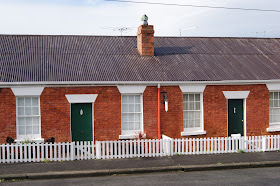Shipbuilding was the first important manufacturing industry established in Van Diemen’s Land – the colony’s blue gum timber was well-suited for boat-building and there was strong demand for trading and whaling vessels. A number of slipyards were established at Battery Point, with some at the bottom of today’s Finlay Street, and the remainder along the foreshore on the eastern side of Napoleon Street.
John Watson was a master shipbuilder who arrived in Van Diemen’s Land in 1833 and spent several years supervising and training convicts at the government shipyards at Port Arthur. In 1839, Watson leased a site on the eastern side of Napoleon Street and began building ships there. Watson is acknowledged as the father of Hobart’s shipbuilding industry and his apprentices included Alexander McGregor, John Gibson McGregor, John Lucas and James Mackey who went on to run successful shipyards on their own account. Watson never owned the cottages that now bear his name.
The amount of shipbuilding activity in the vicinity of Napoleon Street steadily increased during the 1840s with more slipyards established, more vessels launched and larger numbers of workers employed. Shipbuilding is thirsty work and the Shipwrights Arms Hotel which still operates at the top end of today’s Trumpeter Street was first licensed in May 1846. The shipyard workers needed places to stay, as well as places to drink, and there was high demand for rental accommodation in the neighbourhood.
James Poynter, a successful Hobart merchant, had purchased a strip of land sloping down to the River Derwent from the eastern side of Napoleon Street. He had plans and specifications drawn up for a row of four brick cottages along the Napoleon Street frontage. Each of the cottages contained four rooms and there was a cart entry down one side and along the rear. Poynter invited builders to tender for erecting the ‘Four adjoining Cottages’ in the Colonial Times in December 1856.
The brick-built cottages were auctioned in May 1858. Notices in The Courier stated they were ‘desirably situated for the residence of parties whose avocations call them daily to the Wharfs or its neighbourhood, and also as an investment, the certainty of always having occupants at a fair rental enables the purchaser to make a pretty safe calculation.’ They were purchased by Robert Burnett Burgess who lived nearby in Trumpeter Street.
In 1872 the four cottages were purchased for ₤360 by John Downie, a shipwright, who lived in one of them and rented out the other three. In 1919 the cottages were purchased for ₤900 by Thomas Vernon Nicholas, a local butcher with a shop in Hampden Road. The notice in The Mercury advertising the sale had declared that they ‘all let readily, and realise very good rentals.’ In 1922 the cottages were purchased for ₤1,350 by Arthur Robert Reid, the curator of the Hobart zoological gardens (Beaumaris Zoo), who rented them all out.
The ‘Investment Cottages’ were offered for sale in The Mercury in November 1951 and it was noted that each of the four cottages had a laundry, bathroom and toilet at the rear. The advert continued that ‘The situation is very good, overlooking the harbour, and adjacent to transport. We recommend this property as a good investment proposition.’
Today, despite its long history as rental properties, the terrace is in excellent condition. Its front façade, complete with white picket fence, is effectively unaltered from the time when it was first built.
Information Source: Australian Heritage Database






